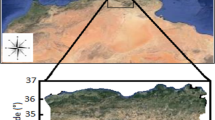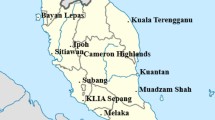Abstract
Modeling pan evaporation (Epan) estimation is a vital issue in water resources management because it directly affects water reservoir and water supply systems. In the developing countries (e.g., India), Epan data are generally limited, and in such a circumstance, theoretical estimates from available climatic data could be beneficial. The study investigates the capability of three adaptive neuro-fuzzy methods, adaptive neuro-fuzzy inference system (ANFIS)–embedded grid partition (GP), subtractive clustering (SC), and fuzzy c-means clustering (FCM), in estimation of monthly pan evaporation using climatic inputs of minimum and maximum air temperatures, wind speed, sunshine hours, and relative humidity obtained from two stations, Uttarakhand, India. Cross validation method is applied by dividing data into three equal parts, and methods are tested using each part. Methods are evaluated by applying various combinations of inputs and using root mean square error (RMSE), mean absolute error (MAE), Nash–Sutcliffe efficiency (NSE), and determination coefficient (R2) criteria. The ANFIS-FCM is found to be superior to the ANFIS-GP and ANFIS-SC methods in Epan modeling. Cluster-based proposed neuro-fuzzy method increases performance of the best ANFIS-GP and ANFIS-SC models with respect to RMSE by about 9–14% for the both stations. The three ANFIS methods are also compared with each other and Stephen Stewart (SS) method by dividing data into three stages, training, validation, and test. The results indicate the superior accuracy of the ANFIS methods to SS for the same input variables. The ANFIS-FCM generally produces better Epan estimates than the other two ANFIS methods.







Similar content being viewed by others
References
Adnan R, Liang Z, Yuan X, Kisi O, Akhlaq M Li B (2019) Comparison of LSSVR, M5RT, NF-GP, and NF-SC Models for Predictions of Hourly Wind Speed and Wind Power Based on Cross-Validation. Energies 12(2):329
Albayrak S, Amasyal F (2003) “Fuzzy c-means clustering on medical diagnostic systems.” Int. XII. Turkish Symp. on Artificial Intelligence and Neural Networks (TAINN), Turkey.
Cobaner M (2010) Evapotranspiration estimation by two different neuro-fuzzy inference systems. J Hydrol 398:292–302
Eftekhari M, Katebi SD (2008) Extracting compact fuzzy rules for nonlinear system modeling using subtractive clustering, GA and unscented filter. Appl Math Model 32(12):2634–2651
Guven A, Kisi O (2010) Daily pan evaporation modeling using linear genetic programming technique. Irrig Sci 29(2):135–145
Ibrahim S, Khalid NEA, Manaf M (2010) Seed-based region growing (SBRG) vs adaptive network-based inference system (ANFIS) vs fuzzy c-means (FCM): Brain abnormalities segmentation. Int J Electr Comput Eng 5(2):94–104
Jang JSR (1993) ANFIS: adaptive network based fuzzy inference system. IEEE Trans Sys Manag Cybern 23:665–685
Jang JSR, Sun CT (1995) Neuro-fuzzy modeling and control[J]. Proc IEEE 83(3):378–406
Jang JSR, Sun CT, Mizutani E (1997) Neuro-fuzzy and soft computing-a computational approach to learning and machine intelligence. IEEE Trans Autom Control 42(10):1482–1484
Jensen ME, Burman RD, Allen RG (1990) Evapotranspiration and irrigation water requirements. ASCE Manuals and Reports on Engineering Practice No. 70, New York, pp. 332.
Keshtegar B, Piri J, Kisi O (2016) A nonlinear mathematical modeling of daily pan evaporation based on conjugate gradient method. Comput Electron Agric 127:120–130
Kim S, Shiri J, Kisi O (2012) Pan evaporation modeling using neural computing approach for different climatic zones. Water Resour Manag 26(11):3231–3249
Kisi O (2006) Daily pan evaporation modeling using a neuro-fuzzy computing technique. J Hydrol 329:636–646
Kisi O (2013) Evolutionary neural network for monthly pan evaporation modelling. J Hydrol 498:36–45
Kisi O (2015) Pan evaporation modeling using least square support vector machine, multivariate adaptive regression splines and M5 model tree. J Hydrol 528:312–320
Kisi O, Demir V, Kim S (2017) Estimation long-term monthly temperatures by three different adaptive neuro-fuzzy approaches using geographical inputs. J Irrig Drain Eng 143(12):04017052
Kisi O, Shiri J, Karimi S et al (2018) Three different adaptive neuro fuzzy computing techniques for forecasting long-period daily streamflows[M]//Big data in engineering applications. Springer, Singapore, pp 303–321
Majidi M, Alizadeh A, Farid A, Vazifedoust M (2015) Estimating evaporation from lakes and reservoirs under limited data condition in a semi-arid region. Water Resour Manag 29(10):3711–3733
Malik A, Kumar A (2015) Pan evaporation simulation using daily meteorological by soft computing techniques and multiple linear regression. Water Resour Manag 29(6):1859–1872
Malik A, Kumar A, Kisi O (2017) Monthly pan-evaporation estimation in Indian central Himalayas using different heuristic approaches and climate based models. Comput Electron Agric 143:302–313
Mamdani EH, Assilian S (1975) An experiment in linguistic synthesis with a fuzzy logic controller. Int J Man Mach Stud 7(1):1–13
McCuen RH (1998) Hydrologic Analysis and Design. Englewood Cliffs, NJ, Prentice Hall
Mirrashid M (2014) Earthquake magnitude prediction by adaptive neuro fuzzy inference system (ANFIS) based on fuzzy C-means algorithm. Nat Hazards 74(3):1577–1593
Moriasi DN, Arnold JG, Van Liew MW, Bingner RL, Harmel RD, Veith TL (2007) Model evaluation guidelines for systematic quantification of accuracy in watershed simulations. Trans ASABE 50(3):885–900
Muhammad Adnan R, Yuan X, Kisi O et al (2017) Application of soft computing models in streamflow forecasting[C]//Proceedings of the Institution of Civil Engineers-Water Management. Thomas Telford Ltd 172(3):123–134
Penman HL (1948) Natural evaporation from open water, bare soil and grass. Proc R Soc A Math Phys Eng Sci 93:120–145
Priestley CHB, Taylor RJ (1972) On the assessment of surface heat flux and evaporation using large-scale parameters. Mon Weather Rev 100(2):81–92
Sanikhani H, Kisi O, Nikpour MR, Dinpashoh Y (2012) Estimation of daily pan evaporation using two different adaptive neuro-fuzzy computing techniques. Water Resour Manag 26:4347–4365
Seo Y, Kim S, Kisi O, Singh VP (2015) Daily water level forecasting using wavelet decomposition and artificial intelligence techniques. J Hydrol 520:224–243
Shiri J, Marti P, Singh VP (2014) Evaluation of gene expression programming approaches for estimating daily evaporation through spatial and temporal data scanning. Hydrol Process 28(3):1215–1225
Shirsath PB, Singh AK (2010) A comparative study of daily pan evaporation estimation using ANN, regression and climate based models. Water Resour Manag 24(8):1571–1581
Snyder RL (1993) Equation for evaporation pan to evapotranspiration conversions. J Irrig Drain Eng 118(6):977–980
Stephens JC, Stewart EH (1963) A comparison of procedures for computing evaporation and evapotranspiration. Publication 62, International Association of Scientific Hydrology. International Union of Geodynamics and Geophysics, Berkeley, pp. 123-133.
Takagi T, Sugeno M (1985) Fuzzy identification of systems and its application to modeling and control. IEEE Trans Syst Man Cybern SMC-15(1):116–132
Trajkovic S (2009) Comparison of radial basis function networks and empirical equations for converting from pan evaporation to reference evapotranspiration. Hydrol Process 23(6):874–880
Wang L, Kisi O, Zounemat-Kermani M, Zhu Z, Gong W, Niu Z, Liu H, Liu Z (2016) Prediction of solar radiation in China using different adaptive neuro-fuzzy methods and M5 model tree. Int J Climatol 37(3):1141–1155
Wang L, Kisi O, Zounemat-Kermani M, Li H (2017a) Pan evaporation modeling using six different heuristic computing methods in different climates of China. J Hydrol 544:407–427
Wang L, Kisi O, Hu B, Bilal M, Zounemat-Kermani M, Li H (2017b) Evaporation modelling using different machine learning techniques. Int J Climatol 37:1076–1092
Wang L, Hu B, Kisi O, Zounemat-Kermani M, Gong W (2017c) Prediction of diffuse photosynthetically active radiation using different soft computing techniques. Q J R Meteorol Soc 143:2235–2244
Wang L, Niu Z, Kisi O, Li C, Yu D (2017d) Pan evaporation modeling using four different heuristic approaches. Comput Electron Agric 140:203–213
Author information
Authors and Affiliations
Corresponding authors
Additional information
Responsible Editor: Abdullah M. Al-Amri
Rights and permissions
About this article
Cite this article
Adnan, R.M., Malik, A., Kumar, A. et al. Pan evaporation modeling by three different neuro-fuzzy intelligent systems using climatic inputs. Arab J Geosci 12, 606 (2019). https://doi.org/10.1007/s12517-019-4781-6
Received:
Accepted:
Published:
DOI: https://doi.org/10.1007/s12517-019-4781-6




